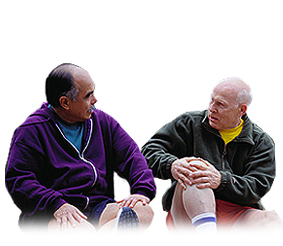Knee Pain SmartSiteTM | ||||||||||||||||||
Using crutches - kneeDescriptionIt is important to start walking as soon as you can after your knee injury or surgery. But you will need support for walking while your knee is healing. Use crutches after knee injury or surgery if you need only a little help with balance and stability, or if your knee is only a little weak or painful. If you are having a lot of pain, weakness, or problems with balance, ask your health care provider if a walker would be better than crutches for you. Crutch basics
Walking and turningWhen you walk using crutches, you will move your crutches forward instead of your weak leg. Follow these steps:
Your provider may give you instructions about how much weight you can put on your weak leg. These may include:
Sitting
Standing
StairsAvoid stairs until you are ready to use them. Before you can go up and down them on your feet, you can sit down and scoot up or down, one step at a time. When you are ready to go up and down stairs on your feet, follow these steps (practice with a spotter first): To go up:
To go down stairs:
If there is a handrail, you can hold onto it and hold both crutches on your other side in one hand. This may feel awkward, so be sure to go slowly. Safety tipsMake sure any loose rugs, rug corners that stick up, or cords are secured to the ground, so you do not trip or get tangled in them. Remove clutter and keep your floors clean and dry. Check the tip or tips of your crutches daily and replace them if they are worn. You can get replacement tips at your medical supply store or local drugstore. To prevent falls, wear shoes or slippers with a rubber or other non-skid or soles. DO NOT wear shoes with heels or leather soles. If you need to carry small items with you, use a small backpack, fanny pack, or shoulder bag to keep your hands free while you are walking. If you have a pet that doesn't follow commands well or that moves quickly, you may want to ask someone to care for your pet early on during your recovery period. | ||||||||||||||||||
| ||||||||||||||||||
Review Date: 8/9/2018 Reviewed By: C. Benjamin Ma, MD, Professor, Chief, Sports Medicine and Shoulder Service, UCSF Department of Orthopaedic Surgery, San Francisco, CA. Also reviewed by David Zieve, MD, MHA, Medical Director, Brenda Conaway, Editorial Director, and the A.D.A.M. Editorial team. View References:  The information provided herein should not be used during any medical emergency or for the diagnosis or treatment of any medical condition. A licensed medical professional should be consulted for diagnosis and treatment of any and all medical conditions. Links to other sites are provided for information only -- they do not constitute endorsements of those other sites. No warranty of any kind, either expressed or implied, is made as to the accuracy, reliability, timeliness, or correctness of any translations made by a third-party service of the information provided herein into any other language. © 1997- A.D.A.M., a business unit of Ebix, Inc. Any duplication or distribution of the information contained herein is strictly prohibited. | ||||||||||||||||||
A.D.A.M. content is best viewed in IE9 or above, Firefox and Google Chrome browser. | ||||||||||||||||||












